MICROSCOPE-ANTIQUES.COM © 2013-20.
LEBRUN SOLAR MICROSCOPE:
c. 1867-8
MAKER: Alexandre Lebrun
Serial Number: None
SIGNED: 'Alexandre Lebrun Ingen. Opticien quai de lecolle,
22 Paris.'

DESCRIPTION

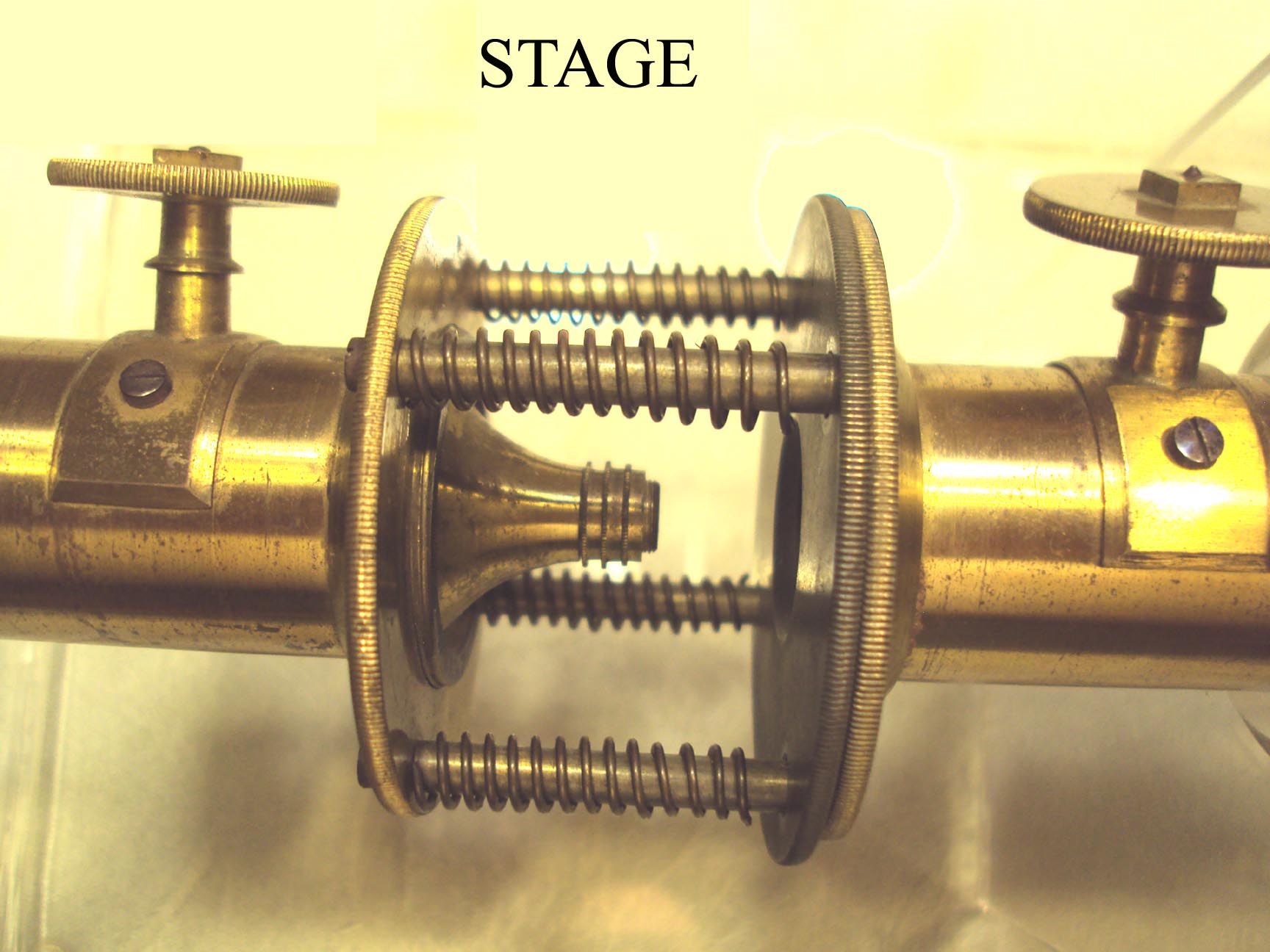
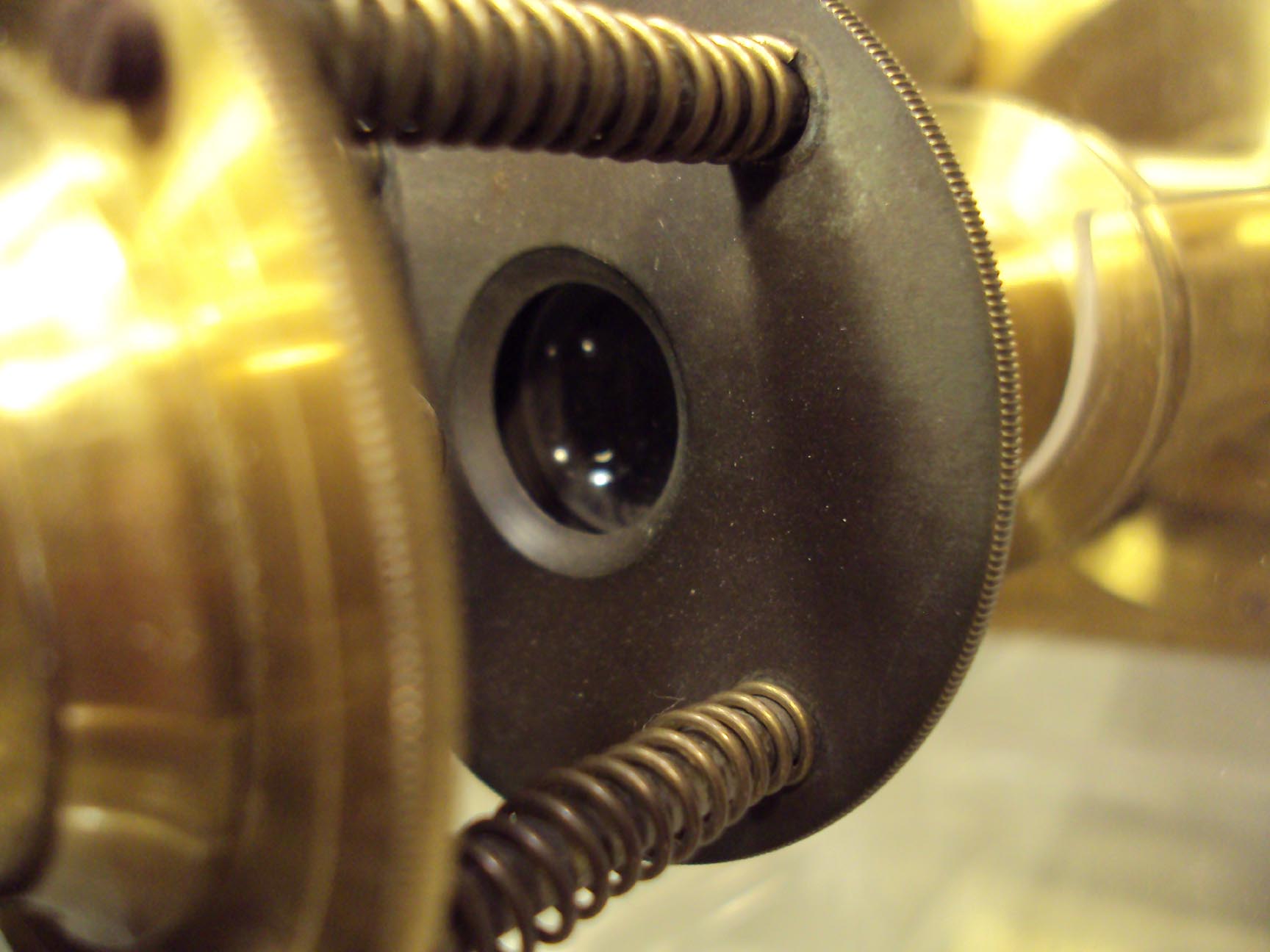 This fine solar microscope has a geared adjustment to the mirror in two planes, including rotational. Rotation is via a
pinion working on a circular rack,
while the angle of the mirror is adjusted via an endless screw acting on a curved rack. The knob for the latter adjustment
moves in a curved slot as the mirror is rotated via the other control.
The projecting lens assembly has rack and
pinion focusing and a Bonani type of sprung stage supported by four pillars, each with its own spring. There is another rack and pinion adjustment to the optical tube for the
built-in
condenser as well. Further, there is a drawtube which may be pulled or pushed allowing the optical tube to be moved
closer or further from the mirror. The objective is the typical French buttom objective with three buttons. There is also an optical element on
the outermost portion of the optical tube which would limit entry of dust or dirt from the outside environment.
There are two supports for the main square-shaped part of the microscope, each one for opposite corners. The optical tube unscrews from
the rest of the microscope to allow it to store in the original case. Accessories included an unusual small fishplate,
a small live trough of brass and glass, two small brass fasteners to allow
quick installation to a shutter, and two knobs which attach to the fasteners. There were likely other accessories
originally, now lacking.
In use, this instrument projects a very good image at its standard power, which has a field of view similar to a low
power objective. It requires a circular opening in the shutter to allow the mirror assembly to rotate.
This fine solar microscope has a geared adjustment to the mirror in two planes, including rotational. Rotation is via a
pinion working on a circular rack,
while the angle of the mirror is adjusted via an endless screw acting on a curved rack. The knob for the latter adjustment
moves in a curved slot as the mirror is rotated via the other control.
The projecting lens assembly has rack and
pinion focusing and a Bonani type of sprung stage supported by four pillars, each with its own spring. There is another rack and pinion adjustment to the optical tube for the
built-in
condenser as well. Further, there is a drawtube which may be pulled or pushed allowing the optical tube to be moved
closer or further from the mirror. The objective is the typical French buttom objective with three buttons. There is also an optical element on
the outermost portion of the optical tube which would limit entry of dust or dirt from the outside environment.
There are two supports for the main square-shaped part of the microscope, each one for opposite corners. The optical tube unscrews from
the rest of the microscope to allow it to store in the original case. Accessories included an unusual small fishplate,
a small live trough of brass and glass, two small brass fasteners to allow
quick installation to a shutter, and two knobs which attach to the fasteners. There were likely other accessories
originally, now lacking.
In use, this instrument projects a very good image at its standard power, which has a field of view similar to a low
power objective. It requires a circular opening in the shutter to allow the mirror assembly to rotate.
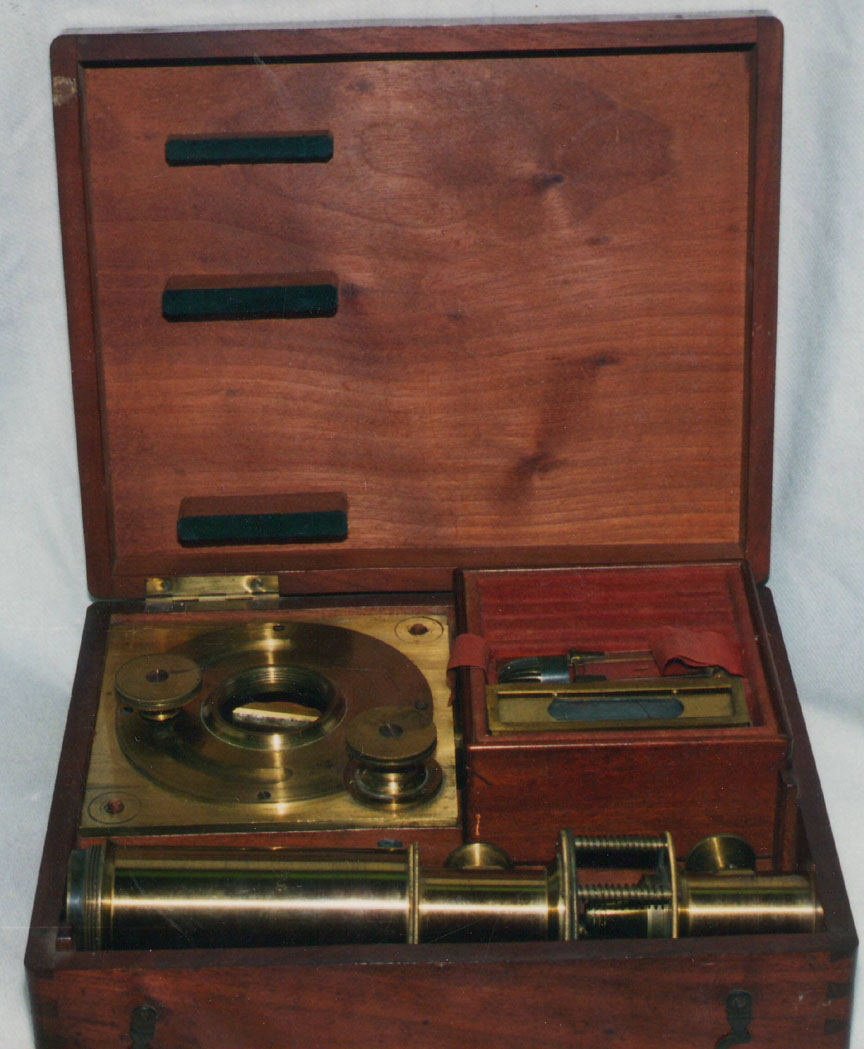
HISTORY OF THE LEBRUN SOLAR MICROSCOPE AND ITS USE
The history of the solar microscope itself is described on the
solar microscope main page.
This microscope was installed through a shutter or other hole in the wall of the house, so that the mirror was outdoors
to capture the bright light of the sun.
Two small brass plates were supplied which could be
attached to the inside
of the shutter via small wood screws; this example has two holes in each of the two little plates; to avoid damage, in the plexiglass stand I have used
nuts and bolts to hold these plates on the plexiglass display rather than wood screws. Each plate has a bigger hole, tapped to accept one of the two knurled knobs
which pass
through the main square part of the microscope; this made attaching and detaching the apparatus from the shutter or other location easier.
The two small brass plates would likely be left behind to enable the microscope to be installed or removed at will.
The installation can be seen in the accompanying photograph of the apparatus set up this way on a piece of plexiglass.
The controls would be used to keep the sun shining through the microscope as the earth rotates. This could also be
accomplished
automatically via a Heliostat, a clockwork-based machine which had an additional mirror which moved with the sun once set
up
correctly.
This French solar microscope is signed in script: 'Alexandre Lebrun Ingen. Opticien quai de lecolle,
22 Paris.'
The word 'lecolle' is likely an error for what should be 'l'E´cole,' which is French for 'school.'
According to research kindly done by Jeroen Meeusen, the quai de l'E´cole is a street which has existed for centuries
near the Seine River and
was renamed quai du Louvre
in 1868 on April 2. The portion of quai du Louvre in front of the Louvre Museum was recently renamed 'quai Francois Mitterand,' but the rest of the
street remains quai du Louvre.
It is interesting that although 'lecolle' is not a valid word in French, the words 'le colle' mean 'hill' in Italian.
It is possible the engraver, working for Lebrun at the time was of Italian descent, which might have led to the apparent mistake
(but 'lecolle' would still be missing a space). As pointed out by my friend Jeroen Meeusen, it may just be that the
engraver simply never got much l'E´cole!
In 1870, a report of the United States Commissioners to the Paris Universal Exposition of 1867, reports, among other things,
on microscope makers at the Exhibition. On page 535 they reported:
In Paris, the house most
remarkable for the cheapness of its microscopes... is that of Mr Alexander Lebrun, Rue Chapon No. 25.
Mr Lebrun has a very large manufactory...It is not to be supposed that, because these prices are so low, the workmanship
is inferior. On the other hand these instruments are elegantly finished...and the optical performance admirable.
Again, research by Jeroen showed the address given in that report was the address of Lebrun from no later than 1851,
and according to the report mentioned above, this was true until at least 1867.
Since the address on this instrument differs from that given in the report for 1867 at Rue Chapon No. 25,
but the quai l'E´cole was renamed quai de Louvre in 1868, it is likely that this instrument dates from between 1867
and 1868. The address given at quai de l'Ecole is indeed near an area
in Paris where instrument makers were known to operate at that time.
Strangely, as is true for some other well known makers of microscopes, few Lebrun microscopes seem to be known or found
in public or private collections.
The author would like to acknowledge the help of Jeroen Meeusen, who alerted me to the mispelling of the word 'lecolle,' and also
helped to clarify much of the information noted above, and also Leon Stabinsky, who first alerted me to the fact that the
quai de l'E´cole had existed in the past. Their help is deeply appreciated.
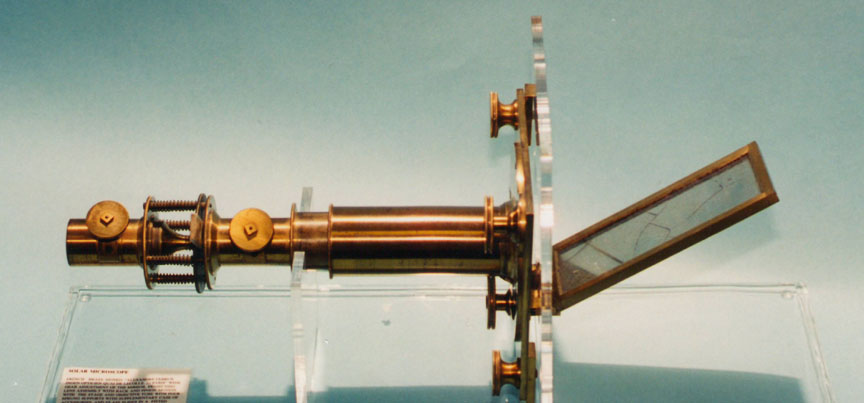
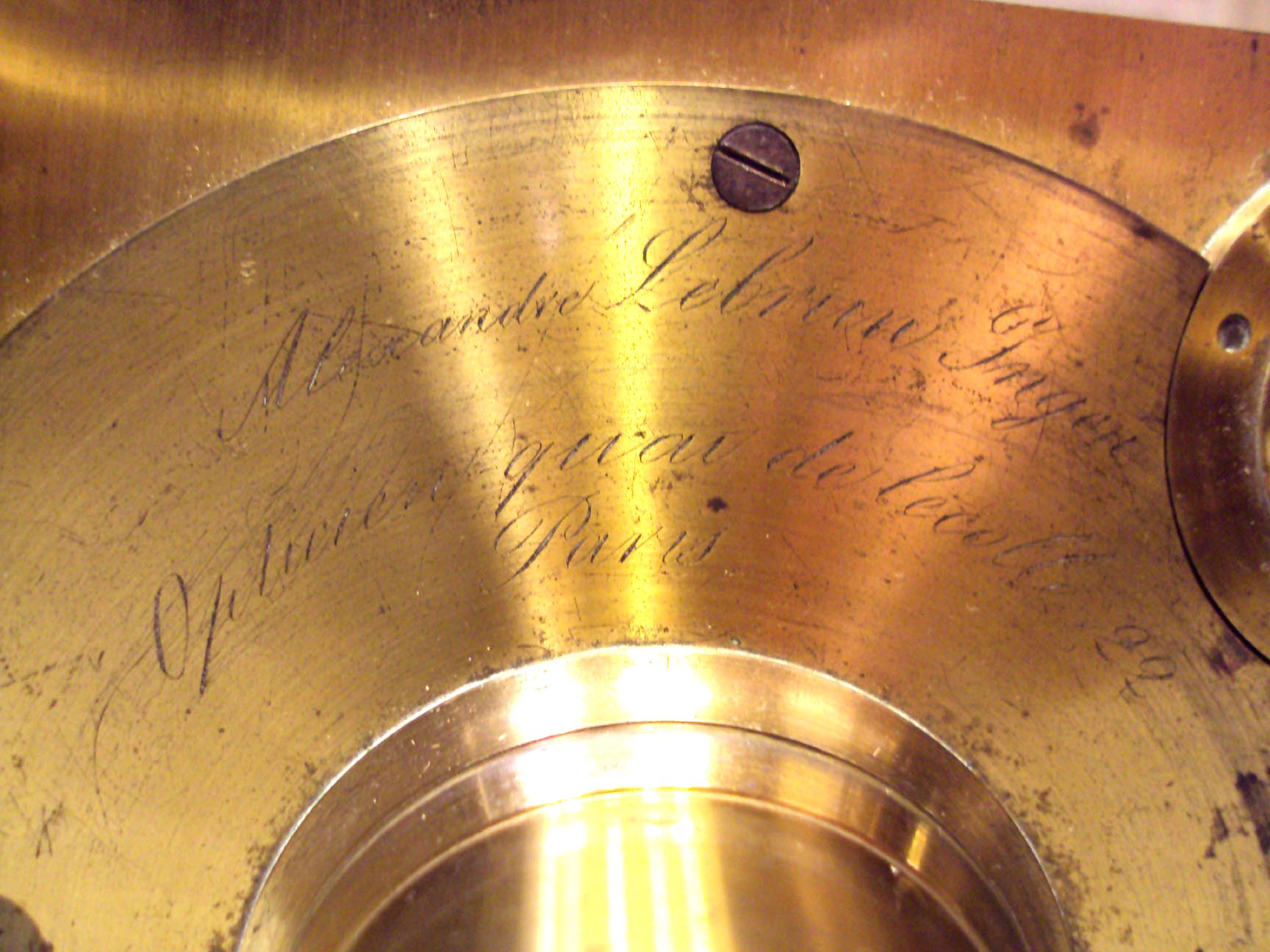


 This fine solar microscope has a geared adjustment to the mirror in two planes, including rotational. Rotation is via a
pinion working on a circular rack,
while the angle of the mirror is adjusted via an endless screw acting on a curved rack. The knob for the latter adjustment
moves in a curved slot as the mirror is rotated via the other control.
The projecting lens assembly has rack and
pinion focusing and a Bonani type of sprung stage supported by four pillars, each with its own spring. There is another rack and pinion adjustment to the optical tube for the
built-in
condenser as well. Further, there is a drawtube which may be pulled or pushed allowing the optical tube to be moved
closer or further from the mirror. The objective is the typical French buttom objective with three buttons. There is also an optical element on
the outermost portion of the optical tube which would limit entry of dust or dirt from the outside environment.
There are two supports for the main square-shaped part of the microscope, each one for opposite corners. The optical tube unscrews from
the rest of the microscope to allow it to store in the original case. Accessories included an unusual small fishplate,
a small live trough of brass and glass, two small brass fasteners to allow
quick installation to a shutter, and two knobs which attach to the fasteners. There were likely other accessories
originally, now lacking.
In use, this instrument projects a very good image at its standard power, which has a field of view similar to a low
power objective. It requires a circular opening in the shutter to allow the mirror assembly to rotate.
This fine solar microscope has a geared adjustment to the mirror in two planes, including rotational. Rotation is via a
pinion working on a circular rack,
while the angle of the mirror is adjusted via an endless screw acting on a curved rack. The knob for the latter adjustment
moves in a curved slot as the mirror is rotated via the other control.
The projecting lens assembly has rack and
pinion focusing and a Bonani type of sprung stage supported by four pillars, each with its own spring. There is another rack and pinion adjustment to the optical tube for the
built-in
condenser as well. Further, there is a drawtube which may be pulled or pushed allowing the optical tube to be moved
closer or further from the mirror. The objective is the typical French buttom objective with three buttons. There is also an optical element on
the outermost portion of the optical tube which would limit entry of dust or dirt from the outside environment.
There are two supports for the main square-shaped part of the microscope, each one for opposite corners. The optical tube unscrews from
the rest of the microscope to allow it to store in the original case. Accessories included an unusual small fishplate,
a small live trough of brass and glass, two small brass fasteners to allow
quick installation to a shutter, and two knobs which attach to the fasteners. There were likely other accessories
originally, now lacking.
In use, this instrument projects a very good image at its standard power, which has a field of view similar to a low
power objective. It requires a circular opening in the shutter to allow the mirror assembly to rotate.


